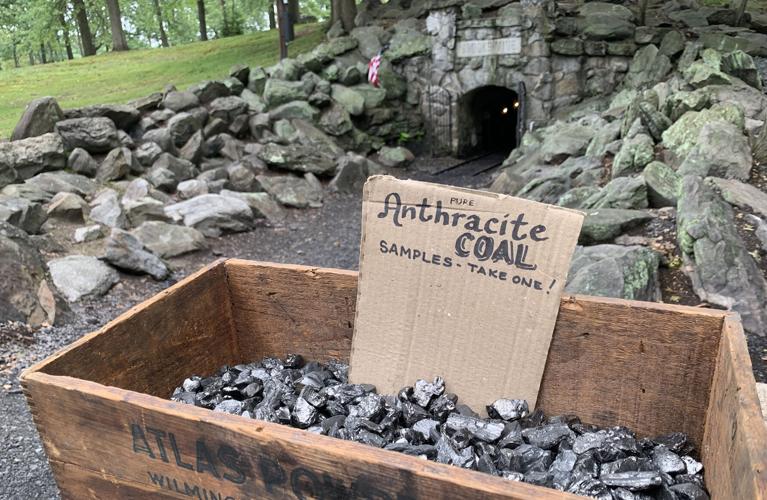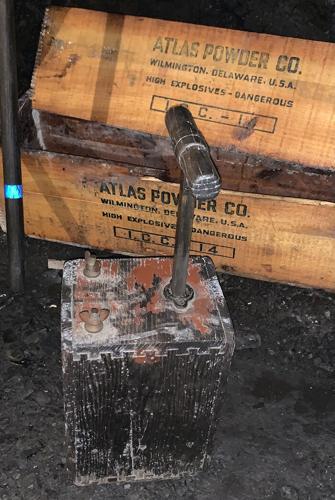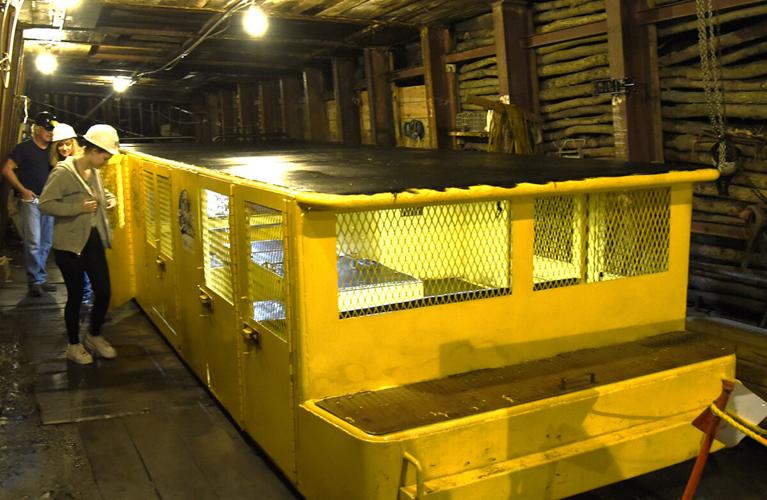
Anthracite coal is free for the taking at the entrance of the Brooks Mine in Scranton, PA, which opened for touring in August 2023.
As she made her way out of Pennsylvania’s newest coal mine tour near Scranton, PA, an elderly woman stopped to thank one of the tour guides.
“This is so interesting,” she said in the dimly lit, occasionally dripping rock tunnel drilled into an outcrop in the city’s historic Nay Aug Park. “And it’s so important! I’m glad you get younger people in here, because they don’t remember.”
She was preaching to the choir, as it were. The tour guide was a volunteer with Underground Miners, the coal history group that spent two years refurbishing the Brooks Mine before opening it to free guided tours every weekend.
That people are in danger of forgetting northeast Pennsylvania’s impactful mining legacy is at the heart of the nonprofit group’s motivation to reopen the mine, which was built in 1902.

Visitors admire a restored electric mine locomotive during the Lackawanna Coal Mine Tour near Scranton, PA.
The anthracite coal dug here, in what is known as the Northern Coal Field, fueled much of the country’s Industrial Revolution and drove multicultural settlement of many towns in this part of the state.
The mines employed hard-working men, women and children who labored in miserable conditions. There were no child labor laws, and the miners were underpaid and risked death every day from explosions or tunnel collapses. From 1870 to about 1960, 30,000 miners were killed working the anthracite mines of northeastern Pennsylvania. And countless thousands died young from black lung disease, caused by decades of breathing coal and rock dust. Life expectancy for a miner in those days was 65.
“We’re a generation away from a lot of this being forgotten,” said Underground Miners member Greg Bock, whose grandfather was a coal miner in the area. “The younger generation that I interact with have no clue that this went on here.
“Organized labor started right here. These guys suffered and toiled in here to get us what we have today.”
Actually, Brooks Coal Mine never sent any coal to market. Only 150 feet long, it was built by local mine entrepreneur Reese Brooks to train mine workers and engineers — and even then as a showpiece to educate the public about the region’s economic engine.

Underground Miners co-founder Chris Murley helped restore the Brooks Mine in Scranton so that the public doesn’t forget northeastern Pennsylvania’s coal history.
But it’s an authentic representation of the mines of its time, with a rail line for carrying workers, two exposed coal seams and timber beams that kept overhanging rock from tumbling down. Miners in training learned that any splintering or shifting in those beams might be their first warning of an impending collapse.
It opened to visitors on Aug. 11 — the fourth such exhibition mine in the region. Unlike the other three, with more extensive and structured tours, the Brooks Coal Mine tours are free and visitors can linger as long as they want.
As you walk into the mine, you are immediately enveloped by not only darkness but also temperatures of 50-some degrees, regardless of the season. Most visitors wear sweaters or light jackets. Expect to duck at times to avoid encounters with the rock ceiling.
On a recent tour, visitors were greeted by volunteer Isaac Walker, there to demonstrate the evolution of head lamps and lanterns used in unlit mine shafts — from original oil lamps to the battery-powered models of today.
Farther down the flat mine, Chris Murley, a licensed miner and co-founder of Underground Miners, put his full weight into a 6-foot, hand-turned breast auger that was used to drill holes that miners filled with gunpowder and later dynamite. They’d wire the charges, seek cover and blast away the rock and coal.
Around a corner, another volunteer explained the uses of mining tools and their evolution over time. There was even a fake rat, a prop for Mark Izak to tell the group, “Rats were your friends. If you saw them running out of the mine, follow them!”

Visitors can see a coal vein as part of the Brooks Mine tour in Scranton, PA.
Also among the guides was Adam Zuroski, whose mining roots run deep. His grandfather and his grandmother’s first husband both died in local mining accidents.
He has helped restore other exhibition mines in the area, as well as mine cars and other equipment. About half of the group’s 30 members have worked in mining at some point.
One of the visitors this day was James Seif, a former head of the Pennsylvania Department of Environmental Protection who was seeing his first anthracite mine.
“We have to correct problems of the past, like acid mine drainage and global climate change,” he said. “Still, we can respect [the miners’] effort, their moxie, their fortitude, their faith that their kids would have it better. And they did.”
This area of northeastern Pennsylvania, known as the Wyoming Valley, at one time held North America’s largest deposits of anthracite coal — which burns cleaner and hotter and was therefore more valuable than the bituminous coal found in western Pennsylvania.
From the 1840s until the 1950s, the region’s anthracite was the choice for heating homes and buildings in the northern U.S. It fed steel and other industries, and it helped win two world wars. Production peaked in 1918 with more than 400 active mines. Today, there are just as many working mines as there are exhibition mines: four.

Detonators like this one were used to blow apart coal seams and rocks in northeastern Pennsylvania’s coal fields.
The Wyoming Valley boomed during those times. Towns and cities sprung up along the major coal veins. Most of them were populated by immigrants who were willing to work 10 hours a day, six days a week for about $1 a day. In 1900, 70% of Scranton’s population were immigrants or first-generation Americans. The 1910 census recorded 26 distinct nationalities in Lackawanna County alone, which represents only about a third of the region.
The veins of coal visible in the Brooks Mine, formed 300 million years ago, are the same ones that miners worked in what was once the Continental No. 190 Slope Mine on the western edge of Scranton. That is now the Lackawanna Coal Mine Tour, which opened to the public in 1985. With all of its twists and turns, the coal seam runs about 7 miles, crossing the Lackawanna River 700 feet below the riverbed.
On a summer afternoon at the Lackawanna mine, 300 feet underground, guide Jim Scanlon told visitors about the origin of the expression “canary in a coal mine.” The diminutive, brightly colored songbirds were placed in mines as a safety measure because they succumb before humans to the buildup of odorless but deadly carbon monoxide gases.
More than once, Scanlon referred to exhibits in the mine as “sad” parts of the mining legacy — not surprising, as he lost both his grandfather and great-grandfather to black lung disease, formally known as coal workers’ pneumoconiosis or CWP.

An electric mine car transports visitors 300 feet underground as part of the Lackawanna Coal Mine Tour in Scranton, PA.
In the early days, if a mining accident killed a worker, his body was laid off to the side until the end of the shift. It was then carried to the surface and transported by a black-covered wagon, known as Black Maria, to the miner’s home. If no one was present, the body would be left outside.
“There were plenty of cases of children finding their father on the front porch,” Scanlon said.
If you go
The Brooks Mine is in Scranton’s Nay Aug Park. Volunteers host free guided tours, no reservations required, 10 a.m. to 5 p.m. Saturdays and Sundays through Nov. 4, 2023. Tours resume in April. For information, go to Undergroundminers.com.
The Lackawanna Coal Mine Tour is in McDade Park in Scranton. Open daily April 1–Nov. 30, the tour includes transport on an old mine car for a 300-foot descent. The walking portion is one-half mile. General admission is $10. For information, go to coalminetournepa.com or call 570-963-6463. Also at McDade Park is the Pennsylvania Anthracite Heritage Museum, open Fridays, Saturdays and Sundays this year through Dec. 10. General admission is $7. For information, visit anthracitemuseum.org or call 570-963-4804.
The Pioneer Tunnel Coal Mine & Steam Train is in Ashland, PA, about 55 miles southwest of Scranton. It is open daily, May through August, offering a 45-minute guided tour of a mine that closed in 1931. Refurbished coal cars carry visitors into the mine. A separate tour includes an above-ground ride on an old steam locomotive to view a strip mine. General admission is $12. For information, visit pioneertunnel.com or call 570-875-3850.
The No. 9 Coal Mine and Museum is in Lansford, PA, about 40 miles from Scranton. It is open Wednesdays through Sundays through the end of November. Mine cars take visitors 1,600 feet into the mountain, followed by a walking tour of the world’s longest-lived continuously operated anthracite mine (1855–1972). Sights include a miners’ hospital and an underground mule path. General admission is $12. For information, go to no9minemuseum.wixsite.com/museum or call 570-645-7074.






(0) comments
Welcome to the discussion.
Log In
We aim to provide a forum for fair and open dialogue.
Please use language that is accurate and respectful.
Comments may not include:
* Insults, verbal attacks or degrading statements
* Explicit or vulgar language
* Information that violates a person's right to privacy
* Advertising or solicitations
* Misrepresentation of your identity or affiliation
* Incorrect, fraudulent or misleading content
* Spam or comments that do not pertain to the posted article
We reserve the right to edit or decline comments that do follow these guidelines.